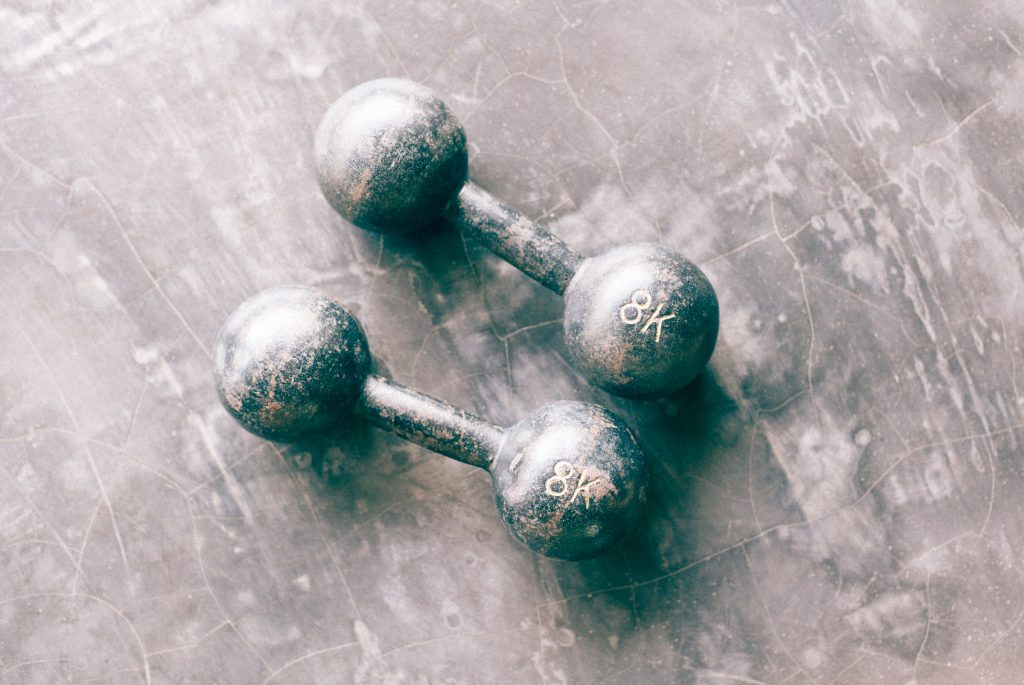Exercise is, of course, important to every person’s health. And for those with inflammatory bowel disease, working out is even more crucial. This post reviews four reasons why exercise plays a big role in managing our health, and I also share my three favorite at-home workouts you can do today.
Why Is Exercise Crucial?
For people with ulcerative colitis or Crohn’s Disease, working out can have some life-changing—and potentially life-saving—benefits.
1. Exercising reduces stress
Whether it’s cardio, weight lifting, calisthenics, yoga, or something else, exercise increases endorphins and reduces stress!
For some of us, stress can trigger flare ups. Keeping stress at a minimum heightens overall health by decreasing the chances of those painful flare ups. (Not to mention, it can help our overall mental health, too!)
2. Exercise improves bone health
Weight training can increase your bone density and overall bone health. People with IBD are at a higher risk of bone density loss, and therefore, osteoporosis down the road.
One reason for this is because flare ups can cause malnutrition, resulting in vitamin deficiency and the loss of bone density. Building up muscle strength is beneficial now and decades in the future.
3. It can help boost your immune system
Many factors play into boosting your immune system, and regular exercise is one of them.
Many people with IBD have a weakened immune system. This is commonly caused by our medications, oftentimes corticosteroids or immunomodulators, which limit the inflammation in the GI tract by lowering the activity of the entire immune system.
Exercising can help strengthen our immunity and protect us against getting sick.
4. Exercising helps surgery recovery
All aspects of a healthy body—heart, muscles, strength, stamina—can help you recover from surgery more efficiently.
Not everybody with IBD will require bowel surgery; but the better shape you’re in, the quicker you’ll recover if you do need to take the surgery route.
I try my best to work out regularly and stay strong, so if I ever do need emergency surgery, I’m as prepared as I can be.
Why My Hospitalization Encouraged Me to Get Back into Working Out
During my five-day hospitalization in 2018, I had non-stop diarrhea and I was placed on a strict liquid diet for my entire hospital stay.
This diet left me in a constant state of hunger; I was always sleepy and weak. So when the physical therapist came by to take me for a few laps around the hospital hallway, I was extremely weak, slow, and out of shape.
When I finally returned from the hospital, I was roughly ten pounds lighter. I’m an ectomorph with a naturally small frame, so ten pounds was a lot for me to lose—especially because that weight I lost was all muscle.
The six-pack outline once beginning to show? Gone.
The slight definition of my biceps? Vanished.
The glutes I’d worked so hard for? Flat.
So I slowly built back my strength by walking. I’d walk around my apartment complex daily. I’d travel about a mile, with a much-needed fifteen-minute rest halfway through. Once I was strong enough to do this, I started lifting light, two-pound weights and slowly increased from there.
My Three Favorite Workout Routines
After my hospitalization, I followed three workout routines that slowly helped me regain my strength.
Total Arm Workout by XHIT
My absolute favorite arm workout during this recovery time was Xhit’s Total Arm Workout coached by Rebecca Louise.
It covers everything: Biceps, triceps, forearms, shoulders!
And the great thing is that you can perform all the exercises with any dumbbell weight you’re comfortable with. I started with a two-pound weight and worked up to five pounds as I recovered.
10-Minute Ab Workout by Alexis Ren
I adore this 10-Minute Ab Workout, demonstrated by Alexis Ren. It’s only ten minutes, but really challenging.
There are about sixteen different movements in this video, each performed for thirty seconds. I used to be able to follow the video until the end, but as I recovered from my flare, I could only do a quarter of the video. And that’s okay! Just do what you can.
Legs & Glute Workout by Tone It Up
My legs were the weakest part of my body after my hospitalization. Knowing this, I did this Malibooty workout by Tone It Up as often as I could. It’s not too difficult, yet, when done regularly, you can feel the results.
I won’t lie. The hospitalization was a setback. But by doing these workouts whenever I could and stopping when I needed to, I built my strength back up over time.
Related Posts
